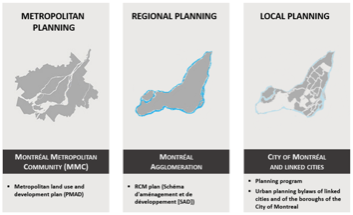Through a number of pilot projects concerning the greening and conservation of natural environments, heat islands, water management, flood prevention, and equity, knowledge has evolved in recent years on how to install green infrastructures and develop ecological neighbourhoods in brownfields. Their transformation, just like that of low-density neighbourhoods, is an interesting avenue to enable the City to develop while preserving existing natural environments.
A partnership between the City of Montréal and Ouranos began in 2017 and was renewed in 2020. It contributes to the knowledge needed to further specify the adaptation measures to be implemented by the actors of the agglomeration. The purpose of this partnership is notably to link research efforts to the City’s needs, share the expertise, encourage the dissemination of knowledge and data, as well as implement integrated adaptation research and development initiatives. The partnership constitutes a forum for reflection on the many issues related to adaptation to climate change and action on the scale of the Montréal agglomeration; privileged access to climate knowledge and its integration into the city’s policies, tools and practices; a lever for building bridges between research and practice; an opportunity to develop knowledge in the area of climate adaptation and to bring about a change in practices while fostering innovation.
A Université de Montréal project mentioned in the regional plan as an opportunity for brownfield developments, which has since been named MIL campus, has allowed the City to conduct a pilot project in collaboration with the Université and the surrounding boroughs. This project, built on the former Outremont classification yard, incorporates green spaces and a rainwater collection system. Other ecological neighbourhood projects are being planned on brownfields.
The project team identified a number or recommendation the next time the regional plan is revised, including:
- Constraint mapping related to topography and natural drainage
- Provisions to preserve and enhance the role of street drainage
- Provisions to develop floodable parks
- Provisions for the use of green infrastructure, notably paired with road repair projects
- Provisions that would act in compliment with the City’s Bylaw to reduce roof runoff
- Provisions concerning the installation of parking lots
- A more constraining provision for the conservation of mosaics of natural environments
